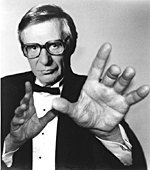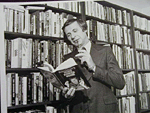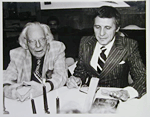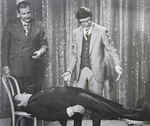| The
Celebrity Collector
The Amazing Kreskin
Collects Items Related to ESP
and the Powers of the
Mind
By Ken Hall
You probably don't have to
be psychic to guess that The Amazing Kreskin collects items related
to extra-sensory perception and the powers of the mind. The
internationally known mentalist-magician has been accumulating such
things since a relative gave him a copy of a Mandrake the Magician
comic book in the early '40s. Kreskin was 5. The gift turned out to
be an epiphany.
"That book, which I still
own today, stylized in my mind what I wanted to do the rest of my
life," Kreskin said from his home in Essex County, N.J., where he
lives with his mother, Lucy, who's 95. "Mandrake was dressed in
top-hat and tails, like a magician, but he used telepathic powers to
solve crimes. That really inspired me. I knew from the start I
wanted more than just sleight-of-hand."
As it turned out, though,
that's exactly how Kreskin started out. He began performing
professionally as a teenager, with a show that featured card tricks,
magic and hypnosis. As he honed his act and his abilities -- in
places like Bethlehem and Allentown, N.J. -- Kreskin gradually
introduced thought reading into his act. "If it was working on that
given night, I'd use it. If not, I'd leave it alone."
Kreskin first realized his
unusual gifts as a grade-schooler. Once, when he wasn't picked by
the teacher for a game of "Hot and Cold" (in which a student leaves
the room, then returns to try and find a hidden object while the
others help him with shouts of "Hot!" or "Cold!") he went home and
asked his brother to play the game. What happened then shocked
everyone, including himself.
"My brother Joe went and
hid a penny behind a curtain rod in an upstairs bedroom," Kreskin
remembered. "I had gone outside, but when I came back in, I just
knew instinctively where it was. I walked upstairs, stood on a chair
and brought out the penny. He didn't have to say 'hot' or 'cold'
once." His teachers in those early years recognized Kreskin's
talents and encouraged him along.
For anyone who doubts
Kreskin's mental powers, he extends the following offer: if he can't
find the check for his performance, he doesn't get paid. Over the
years, he's found checks lodged in a chandelier, rolled up in the
barrel of a gun, stuffed into a turkey, and even tucked inside
someone's upper dental plate. "Six times I couldn't find the check,
so six times I didn't get paid," he said.
The Mandrake the Magician
comic that started it all is today just one, albeit the first,
component in a collection that encompasses much in the way of
paranormal reading matter. Kreskin is a voracious reader, consuming
up to four books a night, and his massive library includes comic
books, pulp novels and manuscripts. All are vintage, and all are
related to magic and mentalism.
The Mandrake books, written
by Lee Falk, are among his most cherished. "His comics are still
revered today in Australia," Kreskin said. "I actually got to know
him about eight or nine years ago. We were eating together at
Sardi's in New York City, and he told me I came the closest to
epitomizing Mandrake's characteristics. It was one of the most
moving moments of my entire life."
Kreskin has some original
Mandrake drawing boards given to him by Falk and illustrated by Phil
Davis, Falk's artistic collaborator. "Attempts to do Mandrake on
film have invariably failed," Kreskin pointed out. "It's difficult
to crystallize telepathic abilities, even with special effects. I
remember Fellini giving it a try one time and just giving up. It's
too bad, because the stories are wonderful."
Walter B. Gibson's The
Shadow was another character that captured Kreskin's imagination as
a youth. Today, many copies of the pulp serial from the '30s are in
his collection. "Gibson was an authority on crime and magic, and he
was a friend of Houdini's," Kreskin said. "Through the character
Lamont Cranston (The Shadow), Gibson combined the criminal mind and
the crime fighter mind."
The Shadow, of course,
became one of the most popular radio programs of all time, but it
isn't the only character for which Walter Gibson is known. He also
authored the Super Magician comics of the 1940s, often under the
pseudonym Maxwell Grant. The main character was based on the
real-life magician Harry Blackstone. The premise was that he
performed magic and fought crime.
"I have a copy of every
Super Magician comic book ever produced (it ran about six years),
encased and in mint condition," Kreskin said. "I can't imagine what
they're worth, but you know what? I don't care. These books and
other items are part of the embroidery that make up the fabric of
who I am. They're not for sale, and I don't care to have them
appraised. That's not the point."
Another part of Kreskin's
collection was assigned a dollar value, but only because he received
an offer that was instantly declined. It was a collection of
manuscripts on parapsychology, assembled into 53 hard-bound volumes
by the Swiss magician Stanley Jaks. Kreskin was gifted the volumes
by Jaks' estate when Jaks died, and said no to an offer of $1.25
million for them soon after.
As for Harry Houdini,
Kreskin has nothing at all relating to the famed escape artist. "For
one thing, most of the items supposedly worn or owned by Houdini are
things he didn't go anywhere near," Kreskin said. "It's a great joke
in the industry. I wouldn't trust any of it to be authentic." He
added that Houdini, while being a fabulous escape artist, was
actually a rather poor magician.
"Escaping from things --
that was Houdini's real talent," Kreskin said. "As for his magic
show, it was a 20-minute act, and it was completely unremarkable. He
also decided, late in his career, to get into the movies, and it
drained him of his life savings. He ended up touring as a magician,
and it was a complete disaster. In the end, he died from a blow to
the stomach by a college kid in 1926."
Another figure that holds
great fascination for Kreskin is Howard Thurston, the magician and
illusionist who gained some degree of fame in the first part of the
last century and died in the 1930s. Thurston was good at tossing
cards up into the balcony during a performance -- a trick known as
"card spinning" or creating a "card flourish." Kreskin tells a story
that gives him pause to think:
"I was in Cleveland,
preparing to do a show, and someone came up to me and handed me one
of Harry Thurston's cards. It had gotten lodged between two of the
seats in the balcony and remained there all that time until workers
found it while remodeling. What intrigues me is the fact that I've
been told by people who knew Thurston that I have many of his
mannerisms and traits."
Does this mean Kreskin
believes he's the reincarnation of a magician who died shortly
before Kreskin was born? "Not really. In fact, I don't believe in
reincarnation. My good friend Liberace always told me he thought he
was the reincarnation of the famous pianist Franz Liszt. I've also
gone on record as saying there's no such thing as hypnosis. There is
the power of suggestion, however."
Other items in Kreskin's
unusual collection:
- A hand-made,
opal-studded belt given to him backstage at The Tonight Show by
the father of a boy Kreskin had given a benefit performance for
after his death. Kreskin gave the performance at the family's
home.
- A table used by
charlatan spiritualists in the early 19th century in Baltimore.
The table was designed to rise, leading relatives to believe they
were communicating with the deceased.
- An incredibly lifelike
pair of hands, also from the early 1800s (the heyday of
spiritualism in the United States). The charlatan would make them
appear to relatives of the deceased at a dramatic moment. "You can
imagine what the reaction was," Kreskin said.
- A wand in a black velvet
box used by Indian fakirs (cross-legged snake charmers and
sleight-of-hand artists) from the 1920s.
- The cork from a bottle
of Korbel champagne that Kreskin located amongst a warehouse
filled with similar bottles (but this one had his performance
check attached). "It was one bottle hidden among 22 million
bottles, and I directed the warehouse man directly to it."
- Jewel-encrusted
wrist-cuffs given to him by his long-time friend, the late
Liberace.
- Items from the estate of
the late performer Arthur Godfrey, gifted to him by Godfrey's
estate.
The Amazing Kreskin was
born George Kresge in Montclair, N.J., 67 years ago. He was raised
Catholic by a Polish father and an Italian mother. He had his name
legally changed to "T. A. Kreskin" some years ago. Despite his
incredible talent and resulting fame, his parents early on hoped
that music would be his life. He studied the piano and became an
accomplished pianist.
At the height of his fame,
in the 1960s, '70s and '80s, Kreskin appeared on The Tonight Show
with Johnny Carson 88 times (a record for a guest), The Mike Douglas
Show 118 times (also a record) and The Merv Griffin Show 99 times.
He continues to perform today in Las Vegas and elsewhere, and is a
frequent guest on The David Letterman Show and the Howard Stern
Show.
Fans of The Amazing Kreskin
may write to him c/o Kreskin, Inc., 8 Soder Rd., No. Caldwell, NJ
07006.
2002
|

The
Amazing Kreskin's real name is George Kresge. He was born in
Montclair, N.J., 67 years ago.

A
voracious reader, Kreskin keeps his vintage books in a massive
library at home in New Jersey.

Kreskin has fond memories of his time spent with
Walter B. Gibson, creator of The Shadow.

Kreskin appeared on The Tonight Show with Johnny
Carson 88 times
(a record for a guest).
|